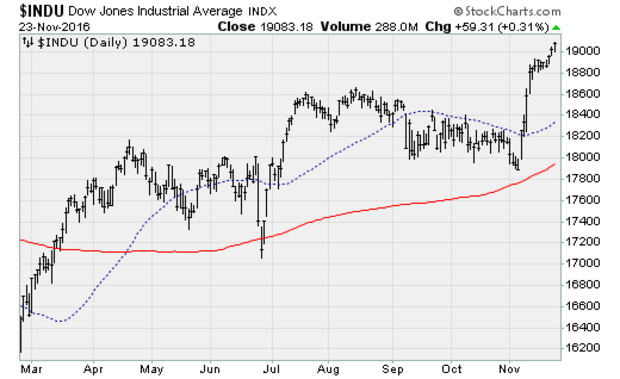Is the Dow, after blasting through 19K, headed for 20K?
The Dow Jones Industrial Average notched another record high heading into the Thanksgiving holiday, pushing even further above the 19,000 level as the meltup that followed the surprise electoral victory of President-elect Donald Trump rolls on. The surge in small-cap stocks has been even more dramatic.
Is Dow 20,000 already on the horizon?
Certainly, investor expectations for an aggressive dose of fiscal stimulus from Trump and seasonal tailwinds that often kick in this time of year are a potent mix. The buying is being sustained by rotation out of bonds, which have been hammered on rising inflation and economic growth forecasts, into areas that could benefit from policies favored by the new administration: materials, financials, transports, retailers, industrials.
Global inflows are being supported by the accompanying surge in the U.S. dollar, which makes American assets attractive relative to the rest of world. For an investor in Japan, for instance, not only is there benefit in the Dow’s upward tear but also in the currency effect: The U.S. dollar index is up nearly four percent since Election Day.
Combined with the Dow’s gains, that’s a combined rise of more than eight percent in just over two weeks. If U.S. based investors fear a reversal, there are many overseas buyers ready to step into the breach.
And besides, bears just don’t have much to stand on at the moment. Corporate earnings and economic growth fundamentals have improved and look solid, while the Federal Reserve’s expected December interest rate hike has now been fully priced in.
The Citigroup Economic Surprise Index, which measures where the economic data is coming in relative to analyst expectations, has jumped back into positive territory as shown above. The improvement seems broad based.
October durable goods orders rose 4.8 percent in October -- suggesting a pre-election lift was already underway -- driven by transportation, well ahead of the 1.2 percent gain expected. The final November consumer sentiment reading came in slightly stronger than expected, showing a post-election boost in optimism. And existing home sales activity increased in October to the best level since February 2007.
Stocks are also getting a lift from a rise in corporate profits. Through last Friday, with 95 percent of the companies in the S&P 500 reporting third quarter results, 72 percent have reported better-than-expected profits, pushing the year-over-year earnings growth rate to 3 percent. That’s the first rise in profitability since the first quarter of 2015, and seemingly marks an end to the profits recession driven by weak energy prices and a strong dollar.
Meanwhile, ‘tis the season for bullish sentiment. Jeff Hirsch of the Stock Trader’s Almanac notes that December is the single best month of the year for the S&P 500 and the second-best month for the Dow, with the indexes seeing average gains of 1.6 percent since 1950. It’s also the top month of the year for the Russell 2000 small-cap index.
So for now, little seems likely to darken investors’ good cheer.
The fiscal realities of what Trump is proposing -- which the Committee for a Responsible Federal Budget warns could double the national debt -- are unlikely to be considered until well after Inauguration Day, perhaps in March when Congress must again consider the government’s debt ceiling.
Any negative repercussions from the rise underway in interest rates are similarly unlikely to be considered until after the New Year. Stocks stumbled at the start of the year following the Fed’s interest rate hike last December, which was the first rate hike since 2006, as the reality of a rising rate environment and the impact on foreign markets became clear.
It’s the same story for corporate earnings. If the U.S. dollar’s surge above its early 2015 highs is again going to hurt the value of foreign earnings, which hit multinational companies harder than those focused on domestic sales, investors aren’t going to hear much about it until management teams start guiding down analyst estimates once the fourth quarter ends.
As things stand now, optimism abounds. The Atlanta Fed’s GDPNow tracking estimate of fourth-quarter growth stands at an impressive 3.6 percent, up from 2.9 percent reported for the second quarter and well ahead of the tepid pace in the first half of the year. And analysts are looking for Q4 S&P 500 year-over-year earnings growth of 3.4 percent.
To be sure, there are niggles if you know where to look. Valuations are slightly stretched. The major stock indices have hit new records in unison for the first time since 1999, pushing dangerously away from their 50-day moving averages. And market breadth -- the percentage of stocks participating to the upside -- has been underwhelming as areas like big-tech and utilities haven’t really participated.
Over the longer term, Trump’s tough talk on trade during the presidential campaign could, if it leads to tougher terms with America’s trading partners, could roil markets.
“[W]e suspect that the risks to the global economy will rise later in Trump’s first term,” said Michael Pearce, global economist with Capital Economics, in a note. “President Trump may, for example, be persuaded to take a harder line on trade if the economy deteriorates or if his approval ratings fall ahead of the next US presidential elections.”
Still, it’s hard to see any of this mattering until the calendar flips to 2017 -- at which point, on its current trajectory, the Dow will be trading above the 20,000 level for the first time in history.





